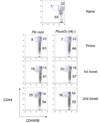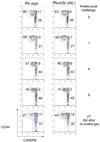Genetically attenuated Plasmodium berghei liver stages induce sterile protracted protection that is mediated by major histocompatibility complex Class I-dependent interferon-gamma-producing CD8+ T cells
- PMID: 17624847
- PMCID: PMC3594113
- DOI: 10.1086/519743
Genetically attenuated Plasmodium berghei liver stages induce sterile protracted protection that is mediated by major histocompatibility complex Class I-dependent interferon-gamma-producing CD8+ T cells
Abstract
At present, radiation-attenuated plasmodia sporozoites ( gamma -spz) is the only vaccine that induces sterile and lasting protection in malaria-naive humans and laboratory rodents. However, gamma -spz are not without risks. For example, the heterogeneity of the gamma -spz could explain occasional breakthrough infections. To avoid this possibility, we constructed a double-knockout P. berghei parasite by removing 2 genes, UIS3 and UIS4, that are up-regulated in infective spz. We evaluated the double-knockout Pbuis3(-)/4(-) parasites for protective efficacy and the contribution of CD8(+) T cells to protection. Pbuis3(-)/4(-) spz induced sterile and protracted protection in C57BL/6 mice. Protection was linked to CD8(+) T cells, given that mice deficient in beta (2)m were not protected. Pbuis3(-)/4(-) spz-immune CD8(+) T cells consisted of effector/memory phenotypes and produced interferon- gamma . On the basis of these observations, we propose that the development of genetically attenuated P. falciparum parasites is warranted for tests in clinical trials as a pre-erythrocytic stage vaccine candidate.
Figures







References
-
- Breman JG, Alilio MS, Mills A. Conquering the intolerable burden of malaria: what's new, what's needed: a summary. Am J Trop Med Hyg. 2004;71:1–15. - PubMed
-
- D'Alessandro U, Buttiens H. History and importance of antimalarial drug resistance. Trop Med Int Health. 2001;6:845–848. - PubMed
-
- Mulligan H, Russel FP, Mohan BN. Active immunization of fowls against Plasmodium gallinaceum by injections of heat killed sporozoites. J Mal Inst Ind. 1941;4:25–34.
-
- Clyde DF, Most H, McCarthy VC, Vanderberg JP. Immunization of man against sporozite-induced falciparum malaria. Am J Med Sci. 1973;266:169–177. - PubMed
-
- Hoffman SL, Goh LM, Luke TC, et al. Protection of humans against malaria by immunization with radiation-attenuated Plasmodium falciparum sporozoites. J Infect Dis. 2002;185:1155–1164. - PubMed
Publication types
MeSH terms
Substances
Grants and funding
LinkOut - more resources
Full Text Sources
Other Literature Sources
Medical
Research Materials

